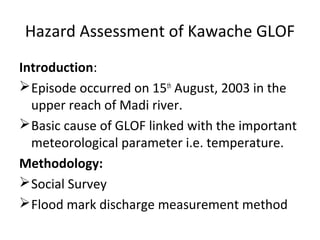
Hazard assessment of kawache glof
- 1. Hazard Assessment of Kawache GLOF Introduction: Episode occurred on 15th August, 2003 in the upper reach of Madi river. Basic cause of GLOF linked with the important meteorological parameter i.e. temperature. Methodology: Social Survey Flood mark discharge measurement method
- 2. Findings: Social survey- Ethnicity dominated by gurung. Most witness the event with experience of- event occurred at night with clear sky, producing foul smell, land shaking and large sound due collision of Boulders. Desertification of fertile land, killing 5 people, deposition of large boulders, trees logs and soil debris. Flood mark up to 5m.
- 3. Flood mark discharge measurement method- Suitable method for flood discharge measurement. flood mark identified through local respondent. Flood discharge at chasu:-30161.43m3/sec Conclusion: Huge magnitude flood has cause huge loss of life and property and also destabilized slope triggering cyclic landslide each year. Monitoring of Temperature trend, detail assessment of life and property loss, study of Geomorphologic changes is necessary to develop useful models.
- 4. Landslide hazard mapping Introduction: provide residents the information on the range of possible damage and disaster prevention activities. based on : slope gradient, slope aspect, elevation, slope shape, geology, land use, soil type, average annual rainfall, distance from a road, distance from a stream, distance from a geological structure and distance from a major ridge line (Paudyal and Dhital 2005).
- 5. Methods of Hazard mapping 1. Digital Grid: Cumulation of rating at each grid Superimposing different maps with rated grid sheet Generally, used PC software- SHIVA (wagner et al. 1990) 2. Line Hazard mapping: Subdivision of survey line into facets where hazard rating is attributed. Can take narrow area but no Cumulation done.
- 6. Study area: Pokhara valley is a beautiful of natural paradise in western Nepal having Area of 200 sq km. It extends between 25°7' and 28°10'N latitude. 83°50' and 84°50' E longitude
- 7. Pokhara valley are divisible into seven formations: Begnas, Siswa, Tallakot, Ghachok, Phewa, Pokhara and Rupakot Formations (Yamanaka et al., 1982). Observations: A) Mapping parameters index; • Soil depth:- A(<1m), B(1-3m),C(3-6m) & D(+6m) • Vegetation:- 1-2-3-4-5 (no to dense vegetation range) • Slope:- I-II-III-IV-V (Steep to gentle range)
- 8. B) Hazard rating parameter values: S. Reference site Slope Soil Vegetati Soil type Total N. depth on rating 1. Sedi Top colluvial II B 2 Residual 0.36 Bagar Alluvial (1) III C 2 Gravel, sand and silt 0.36 (800m) Alluvial (2) IV D 3 Sandy gravel, sand 0.34 and silt 2. Chahadidada (798m) III C 2 Transported 0.4 colluvial 3. Phyaurek Colluvial fan I A 3 Active colluvial 0.23 o Tudo Alluvial Fan III C 2 Non- active alluvial 1.34 (816m) 4. Bhakund Colluvial fan II B 4 Sand and silt 0.35 e Bagar Alluvial fan IV C 2 Sand, silt and gravel 0.33 (806m) 5. Pame Colluvial fan II B 3 Sand and silt 0.35 (794m) Alluvial fan III A 2 Sand silt and gravel 0.18
- 9. C) Recommended hazard level: S.N. Reference site Total rating Hazard level Range of hazard 1. Sedi Bagar Top colluvial 0.36 Medium Less than 0.30 (800m) (Low) Alluvial (1) 0.36 Medium Alluvial (2) 0.34 Medium 2. Chahadidada (798m) 0.4 Medium Between 0.31 & 0.60 (Medium) 3. Phyaureko Colluvial fan 0.23 Medium Tudo (816m) Alluvial Fan 1.34 Very high 4. Bhakunde Colluvial fan 0.35 Medium More than 0.90 Bagar(806 (Very high) Alluvial Fan 0.33 Medium m) 5. Pame Colluvial fan 0.35 Medium (794m) Alluvial Fan 0.18 Low
- 10. Conclusion: Hazard level is based on cumulative rating grid system. Alluvial fan at Phyaureko Tudo showed very high hazard level. Alluvial Fan at Pame showed low hazard level. Recommended hazard level here is based upon only four parameters but for more reliable result, all parameters introduce above need to be assigned.
- 11. References: Deoja, B., Dhital, M., Thapa, B., and Wagner, A. (Principal Editors), 1991, Mountain Risk Engineering Handbook. International Centre for Integrated Mountain Development, 574- 618 p. Paudyal, P., and Dhital M.R., Landslide hazard and risk zonation of Thankot- Chalnakhel area, central Nepal., Jour. Nepal Geol. Soc. V. 31, 43-50 p.
